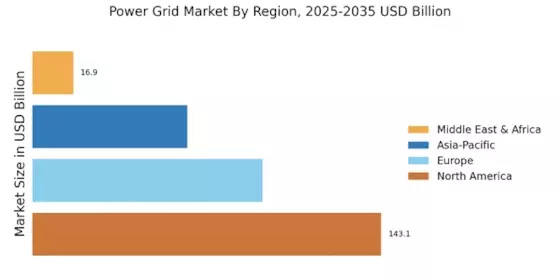Emergence of Electric Vehicles
The emergence of electric vehicles (EVs) is significantly influencing the Power Grid Market. As the adoption of EVs accelerates, the demand for charging infrastructure and grid capacity is expected to rise. By 2025, it is anticipated that the number of electric vehicles on the road will exceed 30 million, necessitating substantial upgrades to existing power grids. This shift presents both challenges and opportunities for the Power Grid Market, as utilities must adapt to increased load demands while ensuring grid stability. Moreover, the integration of EVs into the grid can facilitate vehicle-to-grid technologies, allowing for energy storage and demand response capabilities. Consequently, the Power Grid Market is likely to evolve in response to these trends, fostering innovation and investment in grid enhancements.
Investment in Grid Infrastructure
Investment in grid infrastructure is a critical driver for the Power Grid Market. Governments and private entities are increasingly recognizing the necessity of modernizing aging grid systems to accommodate growing energy demands and enhance reliability. In recent years, investments in grid infrastructure have surged, with estimates suggesting that the market could reach 100 billion USD by 2026. This influx of capital is directed towards upgrading transmission lines, substations, and distribution networks, which are essential for improving energy efficiency. Furthermore, enhanced infrastructure supports the integration of renewable energy sources, thereby aligning with sustainability goals. The Power Grid Market is poised for transformation as these investments pave the way for a more resilient and efficient energy landscape.
Government Policies and Incentives
Government policies and incentives play a crucial role in shaping the Power Grid Market. Regulatory frameworks that promote renewable energy adoption and grid modernization are essential for driving market growth. In recent years, various countries have implemented policies aimed at reducing carbon emissions and enhancing energy efficiency. For instance, tax incentives for renewable energy projects and grants for grid upgrades have become increasingly common. These initiatives not only stimulate investment but also encourage innovation within the Power Grid Market. As governments continue to prioritize sustainability, the alignment of policies with market needs is likely to foster a conducive environment for growth and development in the sector.
Integration of Energy Storage Solutions
The integration of energy storage solutions is a pivotal driver in the Power Grid Market. As the demand for renewable energy sources increases, the need for efficient energy storage systems becomes paramount. Energy storage technologies, such as batteries, allow for the balancing of supply and demand, thereby enhancing grid reliability. In 2025, the energy storage market is projected to reach a value of approximately 20 billion USD, indicating a robust growth trajectory. This integration not only facilitates the incorporation of intermittent renewable sources but also contributes to grid stability. The Power Grid Market is likely to witness a surge in investments aimed at developing advanced storage technologies, which could further enhance operational efficiency and reduce costs.
Technological Advancements in Grid Management
Technological advancements in grid management are transforming the Power Grid Market. Innovations such as artificial intelligence, machine learning, and advanced analytics are being employed to optimize grid operations and enhance decision-making processes. These technologies enable utilities to predict demand patterns, identify potential outages, and improve overall grid reliability. In 2025, the market for smart grid technologies is projected to reach approximately 40 billion USD, reflecting the increasing reliance on digital solutions. The integration of these technologies not only streamlines operations but also supports the transition to a more sustainable energy system. As the Power Grid Market embraces these advancements, it is likely to witness enhanced efficiency and reduced operational costs.


















Leave a Comment